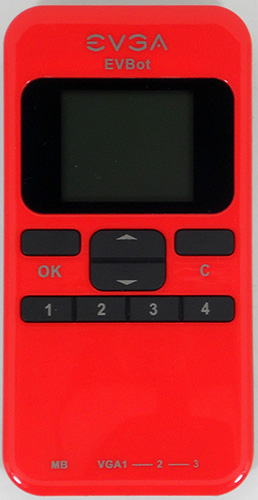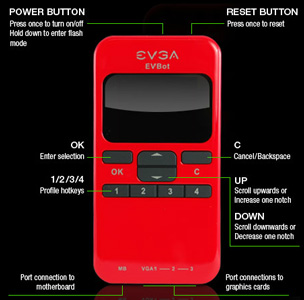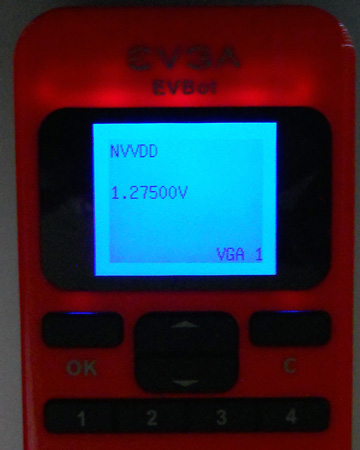EVGA GeForce GTX 680 Classified Review: Pushing GTX 680 To Its Peak
by Ryan Smith on July 20, 2012 12:00 PM ESTOvervolting & The EVGA EVBot
So much of the GTX 680 Classified is geared around overvolting, so we wanted to break this out into its own section.
For some time now NVIIDA has kept a tight leash on their partners' designs, with partners required to clear their designs with NVIDIA before they can sell them. NVIDIA’s interest in this matter is that video card manufacturing is a true partnership – their name and brand is at stake as much as the partners – so they want to be sure that GeForce cards meet their standards. This includes cooling, build quality, and noise limits (the reason the GTX 680C is limited to 55% fan speed). NVIDIA doesn’t publish what those requirements are so we can only speculate from the outside about what’s going on, but clearly NVIDIA has been unhappy with some partners’ custom designs in the past.
With the GeForce 600 series things have become a bit harder for NVIDIA’s partners. As we briefly mentioned before, NVIDIA is shying away from hardcore overclocking with the GeForce 600 series. Specifically, there are two things going on:
- Partners wishing to have a card with a TDP over 195W (i.e. a base power target 170W) must use a custom board with suitable power circuitry. NVIDIA won’t allow partners to ship higher-power cards using the reference board.
- Software overvoltage control is forbidden.
These rules impact two classes of cards. The first are heavily factory overclocked cards using the reference PCB, which goosed the GPU voltage to hit their high factory overclocks. Partners that wish to ship heavily overclocked cards will now need to bin to stay within NVIDIA’s power requirements. Meanwhile the second class of cards impacted is of course overclocking-focused cards like the GTX 680 Classified. Voltage control becomes necessary beyond a certain point, and since NVIDIA is requiring custom PCBs and disallowing software voltage control EVGA had to get creative.
The end result of that creativity is that EVGA has fallen back to their EVBot controller. By using a beefed up PCB along with an external controller, EVGA can offer voltage control while meeting NVIDIA’s guidelines.

The problem with having to resort to this kind of creativity is that it is unquestionably a step back for enthusiasts. Truth be told we don’t mind the voltage lock on reference cards – letting users play with voltage control on cards that aren’t meant for it can definitely lead to problems (e.g. GTX 590). However lack of software voltage control makes the whole thing very messy, as we’ll see in a moment. No doubt NVIDIA has their reasons for going this route, but we don’t believe that anyone has benefitted from a lack of software voltage control on these premium overclocking cards. NVIDIA could and should do better here, since this is effectively an arbitrary restriction that offers no benefit on cards such as the GTX 680 Classified.
Moving on, before getting into the nitty-gritty of voltage control let’s quickly discuss EVGA’s EVBot.
EVBot
Introduced a few years ago, EVGA’s EVBot is a controller intended to offer external control and monitoring capabilities for EVGA’s high-end video cards and motherboards. The device itself is a simple controller with an almost iPod-like design, and contains a small firmware that tells the EVBot how to interact with various devices. The EVBot draws power from the device it’s controlling, meaning it’s basically just a small controller (in the electronics sense) with buttons and a backlit monochrome screen. Finally, 4 headers are found on the bottom, allowing one EVBot to control up to 1 motherboard plus 3 video cards.
Short of an EVGA motherboard or video card, EVBot includes everything else necessary to use it. EVGA includes 4 EVBot cables, so you can control up to the controller’s limit of 4 devices without hunting down any further parts. The 4ft long cables are rather generous, but if you have a large case (like we do) then you’ll want to make sure you have an opening for the cable fairly close to where you intend to keep the controller, as there’s not a ton of slack space to run it behind a full size tower.

Once powered up, the EVBot is pretty simple to navigate through. Depending on the device being controlled different functions become available, with motherboards in particular getting a full range of voltage and clock adjustments, along with hardware monitoring. Video cards on the other hand get a much smaller feature set; the functionality is limited to voltage adjustment. Which means that the EVBot needs to be used in concert with software utilities such as EVGA’s Precision X in order to actually overclock and to monitor that overclock.
Ultimately the functionality EVBot provides for the GTX 680 Classified is essential, but because all it can be used for is voltage control it’s not all that useful. If EVBot could offer full clock control so that you could load a clock and voltage profile at the same time it would be far more useful, and for that matter would be a good hardware analog to what the EVGA Precision X software does.
Finally, if you’re purchasing an EVBot you’ll want to make sure you’re purchasing it directly from EVGA. While EVGA uses a standard hardware interface for the EVBot, the device needs hardware-specific profiles to operate. EVBot’s firmware is upgradable, but only via motherboards, so if you have an earlier firmware then you’re not going to be able to upgrade it for the GTX 680 Classified if the only EVGA product you have is the card. At the same time owners with both an EVGA motherboard and a GTX 680 Classified will want to pay close attention to the EVBot’s firmware limitations – because the EVBot’s firmware is so small, it can only store a couple of profiles. The GTX 680 Classified firmware (P15) doesn’t hold profiles for EVGA’s X79 motherboards, for example.
Overvolting With EVBot
So how does overvolting with EVBot work? For better or worse it’s actually very simple.
EVBot exposes 5 settings on the GTX 680 Classified: NVVDD, FBVDD, PEXVDD1, PEXVDD2, and OCP. These control the GPU voltage, the RAM voltage, the PCIe voltage, and OverCurrent Protection respectively. As is typically the case for video card overclocking, it’s the GPU and RAM voltage that are going to be the important settings for most users.
| EVBot Function Table | ||
| Name | Function | |
| NVVDD | GPU Voltage | |
| FBVDD | Memory Voltage | |
| PEXVDD1 | PCIe Voltage #1 | |
| PEXVDD2 | PCIe Voltage #2 | |
| OCP | OverCurrent Protection | |
Overvolting is simply a matter of dialing in the desired voltage, in the usual 0.0625v increments we’ve come to expect on GTX 680 products. EVGA tells us that GPU voltages up to 1.3v are safe, but of course your mileage may vary and the ultimate goal is to reach the desired clockspeed on as little voltage as possible.

Note that once EVBot is used to take control of the GPU voltage, it overrides NVIDIA’s standard control mechanism and leaves you in full control of the voltage. This happens completely transparently to NVIDIA’s software, which means that any overclocking tools using the NVAPI (which is to say, all of them) will continue to report the voltage the drivers are asking for rather than the real voltage. This makes the voltage monitoring points on the GTX 680 Classified all the more important, since that’s the only way to get a real voltage reading once voltage control is used.
However this also means that voltages are decoupled from NVIDIA’s clock domains. Consequently the GTX 680 Classified will idle at a higher voltage, increasing the idle power consumption of the card. This isn’t a huge problem, but it is a tradeoff for overvolting.
On that note, it’s unfortunate that EVBot voltage settings are not fully persistent. They will survive a soft reboot, but if the card is fully powered down you’ll need to reset the desired voltages the next time the card is powered up. For anyone intending to use an overvolted card on a regular basis, this means you’ll need to keep an EVBot plugged in at all times so that you can reset the voltages. Note that this also effectively precludes having EVGA Precision X or other utilities apply an overclock on startup, since you’ll want to set the voltage first before turning up the clockspeeds.
With all of that said, at the end of the day the EVBot does its job well enough given the limitations imposed by NVIDIA. The fact that this is a separate purchase on top of the GTX 680 Classified is unfortunate, but after thinking it through it wouldn’t make a ton of sense to include the EVBot with the card since all anyone would ever need is the one EVBot. Still, the $80 price tag on top of the $660 card means that GTX 680 overvolting is not for the thrifty at this time.















75 Comments
View All Comments
Belard - Saturday, July 21, 2012 - link
This card is so old-school looking... like an Atari 2600... or 70s camera.ekon - Saturday, July 21, 2012 - link
Few people are aware that EVGA was in the compact camera business back in the 70s:http://tinypic.com/view.php?pic=65bac5&s=6
Belard - Saturday, July 21, 2012 - link
Wow, Amazing!Its so cool how a 1970s camera's lens look just like a blower! What were the chances!
:)
Belard - Sunday, July 22, 2012 - link
Kinda funny. I showed my 7yr old the big picture of this EVGA GTX 680 classified card and he said "it looked really old"... wow.For the retro- look, it does look nice. There will come a time when the computer toys we have today will look like OLD OLD junk.
If mankind makes it another 100 years, our PCs, tablets and GPUs would be like telegraph equipment.
CeriseCogburn - Tuesday, July 24, 2012 - link
That's an amazing comment considering the years long AMD standard block look on 99% plus AMD cards we've been treated to.I remember being sick to my stomache seeing the same old red red red red red pcb on them all. Finally one amd fan promoter claimed he had a blue pcb amd card and linked a pic but it has the same old sad red square cover with the black lines.
I do realize when the amd double D breast design recently hit many fanboys went into some sort of sexually perverse mental mode, but that shouldn't wipe out the endless years of amd standard fare we were all tortured with.
In the case of this card, there's a lot of white on the outside I haven't seen anywhere else, the white "top" with printing will be staring at you out of the case, something so many cards have been oblivious too for far too long... then we also have the black carbon look - another unusual feature although with the fanboysim over anything and everything black that is understandable as I'm sure their pr boys figured that part a clear win, sadly enough.
Haravikk - Saturday, July 21, 2012 - link
With 4gb RAM it seems like it's almost intended to be the ultimate Second Life card; powerful enough to handle that app's mediocre but insanely demanding graphics with the RAM to hold all the hundreds of overly high-resolution textures plastered onto every visible surface.But for $660 I'm not sure it's worth the novelly =)
dave1_nyc - Saturday, July 21, 2012 - link
OK, I know that this is trivial, but the previous Classified at least looked kinda cool and unique. This one seems visually unappealing.CeriseCogburn - Tuesday, July 24, 2012 - link
But once you put it in the case, usually within a few minutes of having an insane "unboxing" session much like a religious pilgrimage with a possible absolutely boring youtube minutes somehow considered a "treat" by the disturbed (of which there are many), you shove it in the case and put on the side cover... never to really see it ever again in it's fully glory, until it's death.What you will see is the big fat WHITE laberl and red classified printing jamming at your face if you have a side window..... clearly the most important aspect - even though 98% don't have a window to look through... but if you do - you're set.
Don't mind me - I'm still amazed how "the feel" of some look makes it or breaks it for 99% of the retarded humans that surround me - especially when "the looking" is done like .000001% of the time as in the case of these video cards.
It must have to do with their estrogen levels I tell myself, or maybe they don't have a girlfriend and that's why...
MrSpadge - Saturday, July 21, 2012 - link
> Software overvoltage control is forbidden.I can understand this for the reference design. But for custom designs? WTF?!
shin0bi272 - Sunday, July 22, 2012 - link
The instant I saw the original 680 I said that the 256bit memory bus was going to limit it severely. Even before I saw any other stats for the thing I knew id never buy one. Nvidia was cheap when they released the 680 because they saw what the 7970 was putting out and they said we'll call our 660 midrange our 680 high end and we can make more money (also love the fact that you guys test the handful of games that amd's 7 series beats the nvidia 6 series... not cherry picking your benchmarks at all nooo).This card does push the 680 to its limit which is cool and all but it just proves that a) the 256bit mem bus is still a midrange card designator no matter how much they claim gddr5 is fast enough to not need more than that... it does. And b) Nvidia could have pushed the 680's base clock up much higher and, while it would still be bottle necked bad, it would have been more attractive.
Bring on the 700 series Im done with the 6's